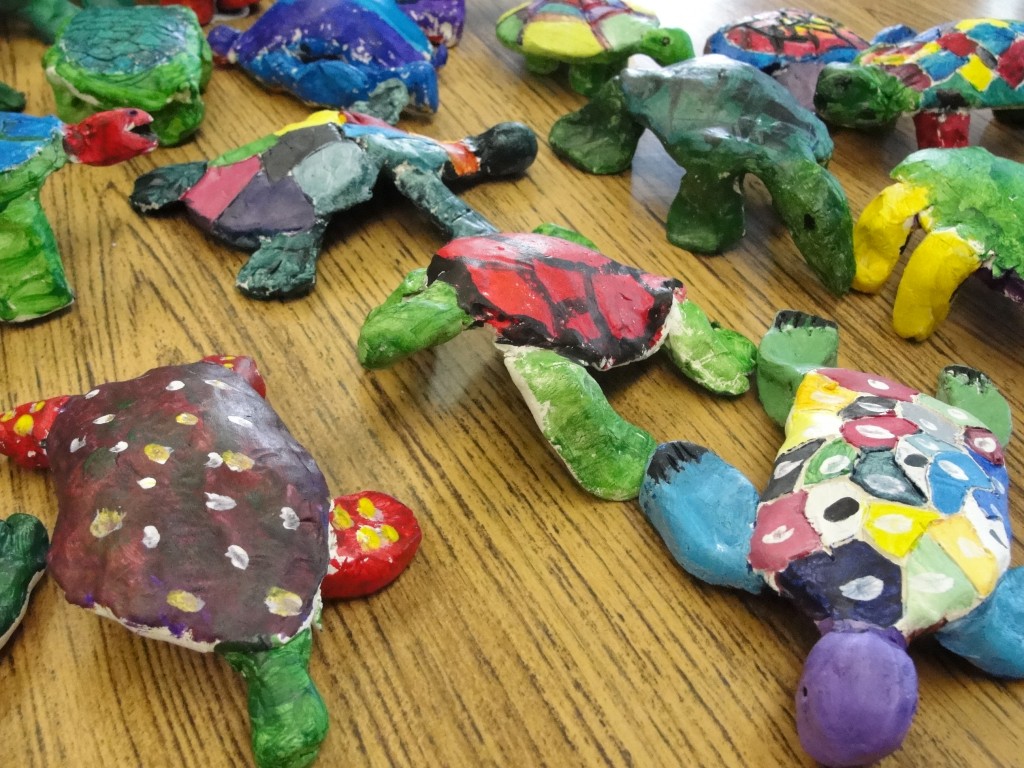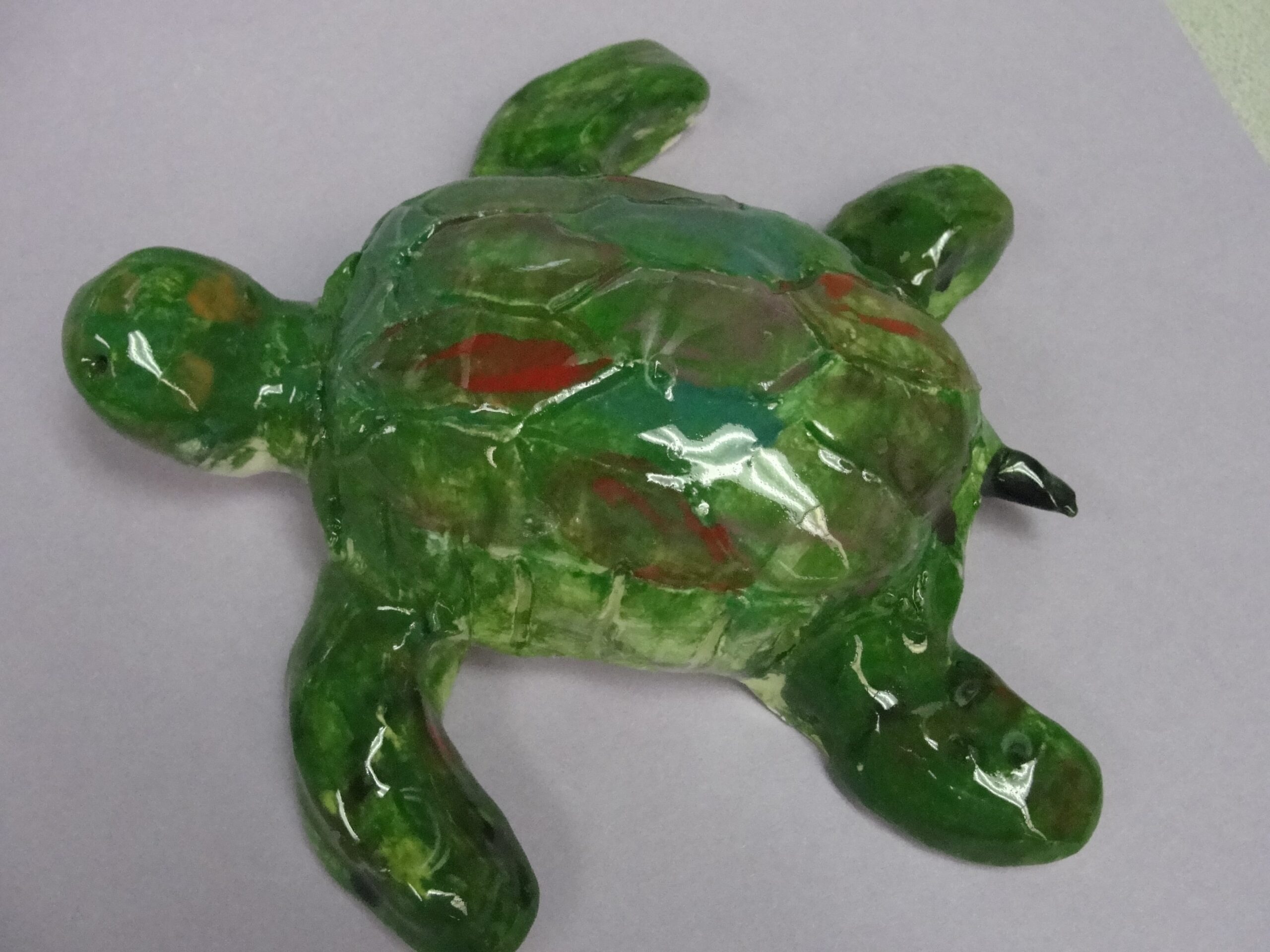
I’m always looking for simple ceramic lessons for my students. I vary the complexities of the lessons according to grade levels, starting with pinch pots in the lower grades and working up to mural projects in the upper grades.
This cute little turtle has become a staple for in fourth grade. Sometimes I use a template as a guide for the shell, other times I don’t. The most important factor with this project is attaching the legs. You need to make sure they’re completely secure or else the turtles will be legless. Sad.
This project uses clay to be fired. If you don’t have a kiln, use air-dry clay. The end results will be different but you won’t be subjected to as many critical steps.
CREATING THE TURTLE
1. Give each student a flat piece of clay. I have a multi-slab cutter that can slice twenty-four tiles at once. I got it at Chinese Clay Art. Great deal if you cut a lot of tiles. Of course, the kids can roll out a slab themselves but this is time consuming. For $24 bucks, much time is saved. Worth considering.
2. Etch a wide oval on the clay tile, using most of the space (this is where a template comes in handy). Cut with a wooden dowel. Save the edge pieces for the legs and head.
3. Set the clay oval in the palm of your hand. Shape to achieve a turtle shell. Using the left-over scraps of clay, form legs, tail and a head. The students will probably need more clay so put a bunch in the middle of their table to pull from.
4. Now it’s time to attach all the pieces together. Using the “scratch-attach” method, score and wet both side of the clay to be “fused”. Use a tool to smooth the crease.
5. Once all the pieces are attached, etch designs into the turtle shells.
6. Let dry for about 10 days. I put a wad of newspaper under teh shells to keep the shape. Fire according to clay instructions.
7. Paint with underglaze and apply glaze. I use Laguna underglaze. They have a great selection of lead-free glazes, but recently I’ve purchased Amaco Underglaze from School Specialty (Saxs). Fired nicely.
8. As an alternate to using underglaze, paint turtle with acrylic paints. I don’t like the results as much, but the students love them just the same!


Want a free download to another Deep Space Sparkle ceramic lesson? Click the yellow download button below and we’ll send you a PDF lesson plan on how to make a ceramic snowman!














Patty- Thank you for the idea about the multi cutter for slabs. I may just order one- We do all of our clay in one month in our curriculum and I do cutting overload! Thanks!
Definitely get the cutter. It saves SO much time.
I love the cutter!
Hi! This lesson is great! We did air dry clay turtles last year but they werent nearly this nice! You gave some good pointers. I have some questions regarding the glaze. Do you have to fire with the undergalze first? Do you dip the entire piece in the glaze? Do you have to let it dry? It wont stick to the kiln as the glaze sets? I have a kiln for the first time this year so glaze is a whole new monster.
You can wipe the glaze off the bottom before you place it in the kiln, but with the turtles you could dip the top of the turtle without getting glaze on the bottom if you were careful. Hope that makes sense. 🙂 I need to get a head start on clay this year because it seems that I always wait and end up rushing towards the end of the year.
I get SO many questions regarding ceramics, I’m in the process of creating a PDF in the hopes to cover all the basics. Meanwhile, here are soem simple answers to your questions.
Do you have to fire with the undergalze first? I do 2 firings. One after the clay hardens and then, after the kids paint the underglaze and I dip the piece in glaze, I do another firing. There is always two firings if glaze is being used. One firing if you just want to use acrylic paint.
Do you dip the entire piece in the glaze? Nope. I hold onto the bottom to make sure it doesn’t get the glaze on. Set glazed piece aside to dry and remove any drippings that accumulate near the bottom.
It wont stick to the kiln as the glaze sets? Unsure what you mean here, but I think the answer is no.
Good luck!
To Julie:
They do have a glaze that can go on before the bisque firing called Stroke & Coat (Sax Arts and Crafts). All you need is one firing and if you fire at the right temp. it will also come out shiny! So you don’t even need the shiny clear coat! You will need to put on at least three coats of glaze and keep the bottom clean. I use the kiln furniture that look like little feet for glazed pieces so it will not get stuck to the kiln shelf during the firing. Also, you can have them just paint the bottom with a watercolor paint after they have been fired and they dry instantly. Good Luck!
I need to get this! Just one firing? Wow. Love this idea!
Thanks for the great idea! I can’t wait to try it with a class!
I don’t have access to a klim, so I paint mine then after they dry dip them in modge podge and let dry on wax paper. This gives the illusion of glaze for they are nice an shiny and have a hard coat on them. The students love them.
Do you use clay fired clay or some other type of clay? Dipping in Mod Podge is brilliant. Such a great product!
I just finished doing this with my 2nd graders! I really like this lesson because it incorporates 2 different clay techniques (pinch pot and coils). The hardest part for my students was getting the right thickness of the turtles legs, they just want to make itty bitty tiny legs and sometimes they break off…well maybe next time I do this project I’ll try a different method:-) I love your website and am thinking about buying a PDF, which one…hmmm..
Hi Patty,
First–I love your site. Your lesson ideas have helped me a multitude of times.:) I am just in my second year of teaching. In a few days I will start ceramics with my third graders. I did this last year too. What I don’t have, however is something to protect the tables so they don’t take half the class time to clean up. I think some people use canvas, but what do you think?
~Sonja
I found some Sumbrella (waterproof) fabric at a garage sale once and cut the yardage into placemat size rectangles. It works great and is stiff enough so kids can carry the placemat to the trash container and “dump” their excess clay bits into the garbage. In the past, I’ve used sulphite paper in the ugly, and rarely used brown. It works well too.